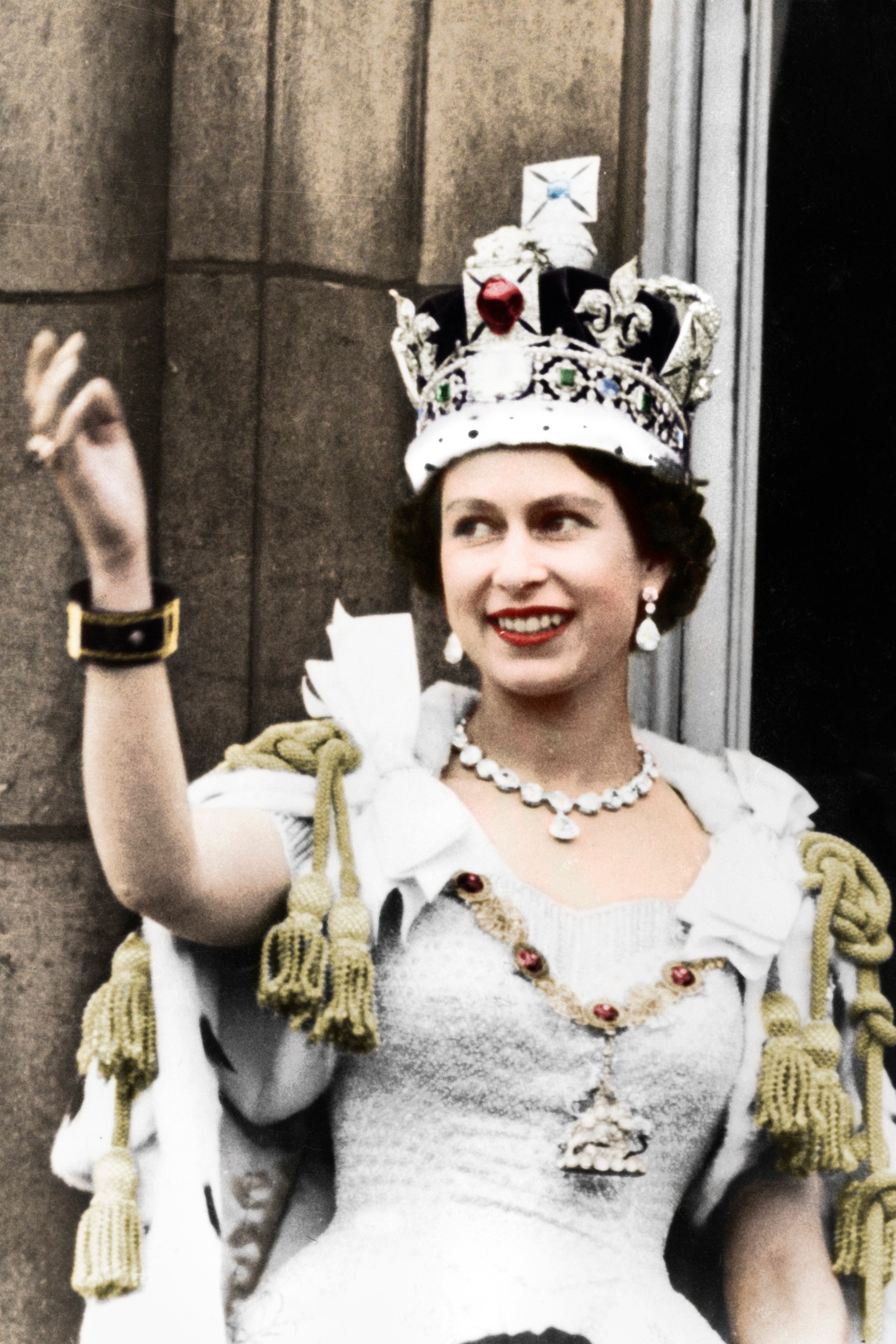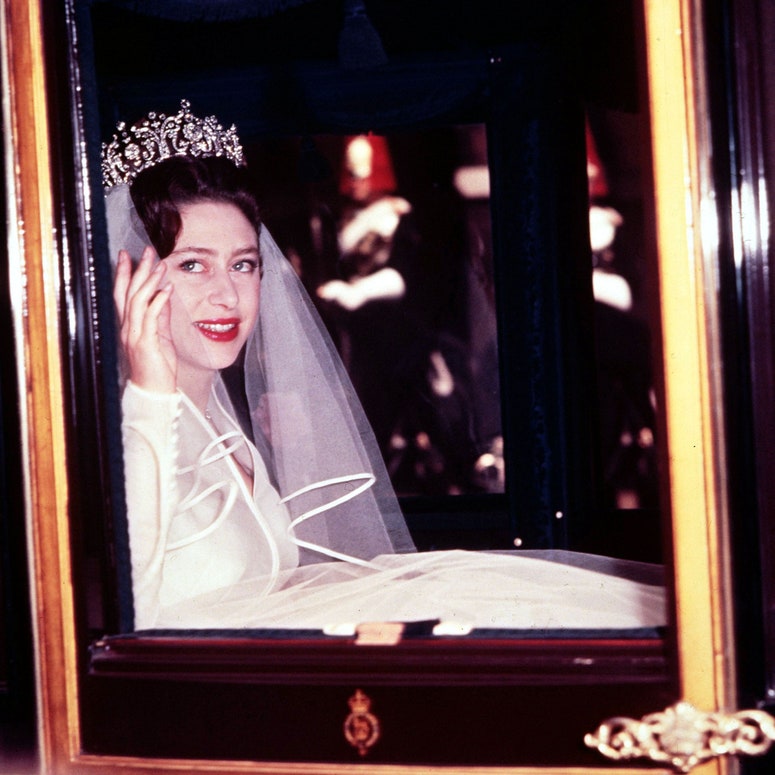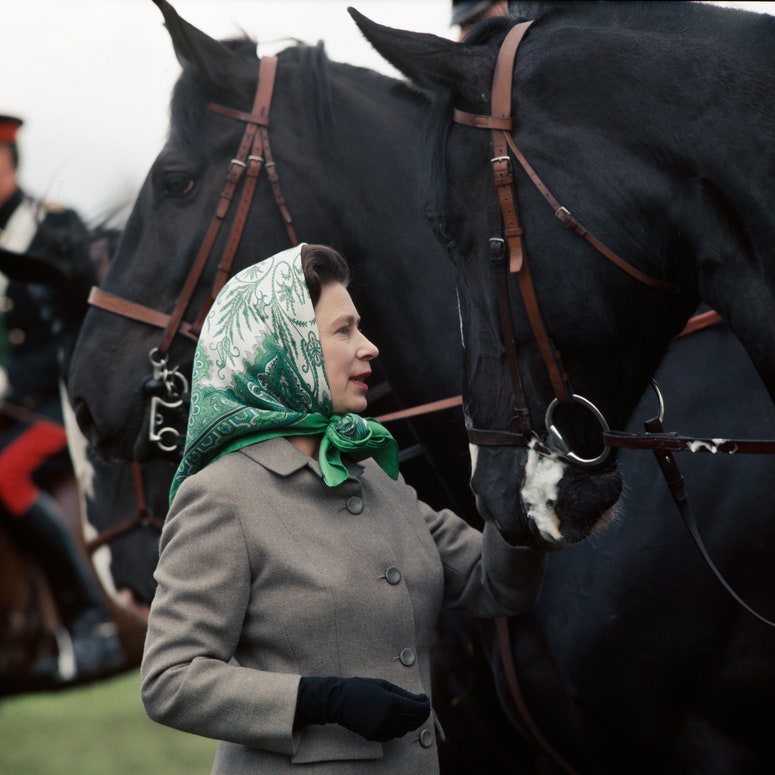On 2 June 1953, Queen Elizabeth II became the 39th sovereign – and the sixth Queen – to be crowned at Westminster Abbey. She was driven from Buckingham Palace to the royal church in the Gold State Coach – pulled by eight grey gelding horses: Cunningham, Tovey, Noah, Tedder, Eisenhower, Snow White, Tipperary and McCreery – resplendent in her white satin coronation dress. Designed by Norman Hartnell, the gown featured the emblems of the United Kingdom and the Commonwealth in gold and silver thread. Her Majesty wore the George IV State Diadem – the crown depicted on Great Britain’s stamps, which features roses, shamrocks and thistles with 1,333 diamonds and 169 pearls – to the televised ceremony.
Once seated in St Edward’s Chair, made in 1300 for Edward I and used at every coronation since then, the Queen was adorned with the country’s most important piece of regalia: St Edward’s Crown. Across the land, 27 million people watched the Queen don the solid gold design – which dates back to 1661 and weighs a total of 4lb 12oz – as well as the ornate orb and the coronation ring (also known as the wedding ring of England).
On the Queen’s jubilant return to the palace, she wore her Purple Robe of Estate (which took 12 seamstresses from the Royal School of Needlework 3,500 hours to complete), and a third crown – perhaps the most fascinating in her collection. The term Imperial State Crown dates back to the 15th century when English monarchs requested a crown closed by arches, to demonstrate that the country was closed to any other earthly power apart from that of their rule, according to the Royal Collection Trust.
The Imperial State Crown, which is fitted with a purple velvet cap and an ermine band, was made for the coronation of King George VI in 1937, but is similar to a headpiece created for Queen Victoria in 1838 by crown jewellers, Rundell, Bridge & Rundell. Within the gold frame, mounted with three very large stones, there are 2,868 diamonds set in silver mounts and coloured stones in gold mounts, including 17 sapphires, 11 emeralds and 269 pearls. Many of these stones bear great historical significance.
St Edward’s Sapphire, for example, once belonged to Edward the Confessor, or St Edward, one of the last Anglo-Saxon kings of England. When asked for money by a beggar, St Edward gifted the stranger his sapphire ring. The precious blue gemstone was later returned to the King by two English pilgrims in Syria, who the beggar – known by that point as St John the Evangelist – had helped, inspired by the kindness the King had previously shown him. St Edward was buried with his treasure at Westminster Abbey in 1066, but his tomb was opened and the ring removed in the 12th century.
At the intersection of the Imperial State Crown’s two arches (or four half arches) – which are cast as oak leaves, set with diamonds – sit four large pear-shaped pearls in rose-diamond caps. These pearls are known as Queen Elizabeth’s Earrings. Elizabeth I allegedly bought the pearls from Mary, Queen of Scots when she was imprisoned, but, the Royal Collection Trust maintains, the former British monarch is unlikely to have ever worn them as earrings. Elizabeth I had a penchant for wearing her pearls scattered over her ruff, pinned in her hair, or adorning her royal dress. The Trust also recalls that at least two of the pearls – which were originally gifted to Catherine de Medici from Pope Clement VII on her marriage to Henry II of France in 1533 – did not enter the royal collection until the 19th Century. Still, the moniker, Queen Elizabeth’s Earrings remains.
The large cushion-shaped brilliant stone, Cullinan II – the second largest stone cut from the Cullinan Diamond (also known as the Second Star of Africa) – at the front of the crown band dates back to 1907. Edward VII received the original diamond as a gesture to help mend the rift between Britain and South Africa after the Boer War. Nine large stones were cut from it by three men from Royal Asscher of Amsterdam over eight months. An additional 97 small brilliant stones and some unpolished fragments were mounted in jewellery but were not admitted into the crown jewels.
The 104-carat Stuart Sapphire, at the back of the crown band, and the 170-carat Black Prince’s Ruby, mounted on the crown’s front cross, were both once pierced and worn as pendants, as their own legends would have it. They have both passed through Europe and the hands of Henry V (he reportedly wore the ruby in his helmet at the Battle of Agincourt) and Queen Victoria (who fixed the sapphire to the front of the band of her State Crown, before it was moved to the rear of the band in 1909 to make way for the newly acquired Cullinan II.)
The Crown of State – as the Imperial State Crown is also known – was initially deemed necessary because, prior to the Civil War, the ancient coronation crown was always kept at Westminster Abbey. New kings and queens required a crown to wear when leaving the Abbey and addressing their nation for the first time as monarch. On 2 June 1953 – after the Queen completed the 7.2 km procession, designed so that she could be seen by as many people in London as possible – she appeared on the balcony of Buckingham Palace still wearing the Imperial State Crown and her royal robes. Her Majesty waved at well-wishers once again at 9.45pm as she switched on the lights of London, which illuminated the floodlights from Trafalgar Square’s National Gallery to the Tower of London.
It is the stately portraits of her standing alongside her husband, the Duke of Edinburgh – a moment captured by 500 photographers, among them Washington Times-Herald reporter Jacqueline Bouvier (who later became First Lady of the United States, Jackie Kennedy) – that are ingrained in the public’s psyche seven decades on from the coronation. She wore the spectacular creation at the state openings of parliament.


